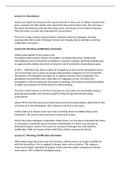Summary
Samenvatting Mariene wetenschappen 3 (III) B-B3MSCI05
- Course
- Institution
Deze samenvatting bevat aantekeningen van de hoorcolleges van het vak Mariene wetenschappen III wat wordt gegeven aan de Universiteit van Utrecht. Het document bevat 29 pagina's en ik heb geprobeerd alles zo uitgebreid mogelijk op te schrijven. De colleges die er in staan zijn: introductie, WAA, cl...
[Show more]



